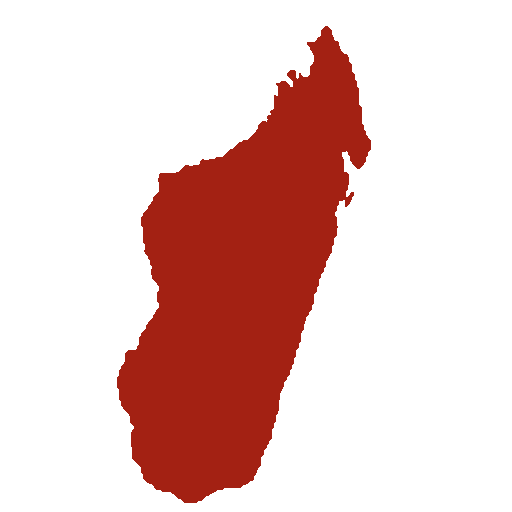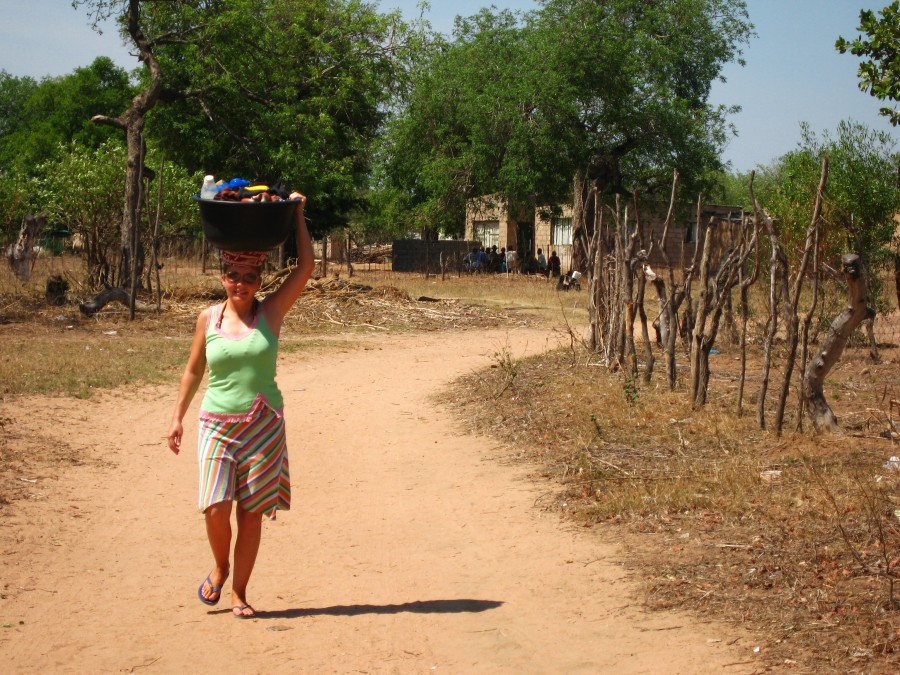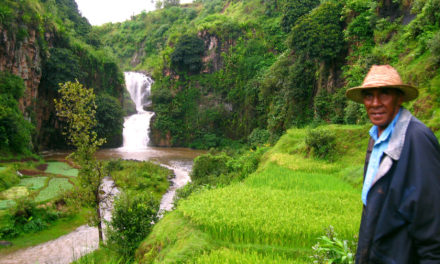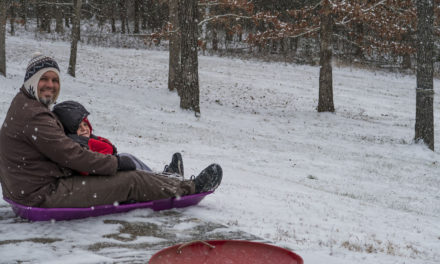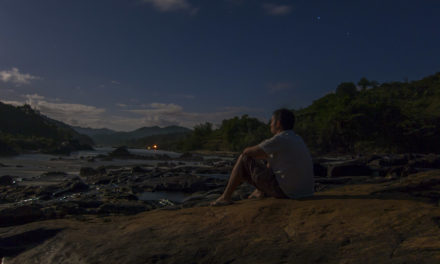Adjusting is definitely more than just living arrangements. One of the first areas we’ve had to adjust to is the drastic difference in climate here… both in temperature and humidity. Though we’ve been here at our village for just over a month now, I can say it’s only in the last week or two that the issue of water has really begun to sink into our psyches. What the water issue really comes down to is a huge shortage of it… this year especially. Living with such a scarcity of water, it really teaches us the value of something we’ve so often taken for granted – just like the air we breathe.
In our village, Dumphries, there is no water supply and tap system like we’re used to in America. No one, including us, has running water inside their home. That means no sinks for washing vegetables or dishes. No showers or tubs. No flush toilets. Certainly no dishwashers or washing machines.
The only way to store and use water is with huge jugs and large bowls. That means that anyone who wants water has to go fetch it from a limited range of water supply choices and transport it back to their home. There are really only a few sources of water in the whole of Dumphries A and Dumphries B. Out of the three main options, most (because of lack of money) are dependent on just two: village wells or the river.
For those with enough money (what you might call the “elite” of the village – those few teachers and few others with jobs outside the community), they can hire someone with a pick-up truck to transport large jugs of water from a nearby town. In American terms, hiring someone like that is relatively inexpensive, but in Dumphries terms, the number of people who can afford it are very few.
So for the rest, there’s the village wells and the river. There’s maybe five to ten wells scattered throughout the village , fairly shallow but many of them are in easy-to-access locations. When rain is plentiful so is water in the wells. But during the rest of the year, especially by this time, they can dry up entirely. In general, the well water seems to be a bit cleaner than the river, but when they start getting low, the pollution and general dirtiness starts becoming obvious.
On the other hand, if we were to walk at a brisk pace straight to the river’s water supply point from our part of the village, while carrying nothing, it would take a minimum of 30 minutes. With the unusual lack of rain this year, that area is also sometimes dry and then people have to either dig a deep hole into the river bed or search even further upstream or downstream.
The jugs for collecting water (usually 20-30 liters each) have to be carried completely on foot, including up and down a few somewhat steep hills. Many people have wheelbarrows so that they can bring a few at a time, but some people, especially women, carry the buckets on their head, which allows only one at a time. As you can imagine, this trip can require well over an hour of hard labor and it’s something that has to be repeated every day or two since most people also have very large families and many children.
Since the river is rarely flowing rapidly and sometimes just dries up, the water that most people are using for drinking, bathing, cooking, etc. is also stagnant water. There’s no way of knowing what pollutants may have entered the water upstream or from land run-off on the rare occasions that it does rain.
On Saturdays, people have the strenuous chore of transporting their clothes to and from the river for washing them – mixing laundry detergent into the river for anyone who might be fetching water downstream. Thankfully, they don’t drink much water anyway and almost all food is prepared by boiling, so it’s likely that the most harmful elements in the water are sterilized.
For Lora and me, we’re not given enough money by the Peace Corps to pay someone to bring us water every time we need it. But the schools who are hosting us have allowed us to get water from their boreholes and water storage tanks. One of our schools is only about half a kilometer (maybe 1/3 of a mile) away and it’s only a minor uphill slope on the return to our house.
So we take a wheelbarrow and fetch about 130 liters of water twice a week. It’s definitely a workout, but it’s much easier than most of our neighbors’ only options. Because it comes from deep down and it’s not open to the air, it’s very clean water and has only a very small amount of sediment in it. We use the water for bathing, washing our hands, cooking, drinking, and washing our clothes. Peace Corps also provided us with Brita water filters, so everything we drink, we filter first.
You may ask why the schools don’t allow the entire community to have access to such a ready supply of clean and nearby water. Well, that goes back to the lower-than-average rainfall this year and the fact that there really never is muchrain in Dumphries.
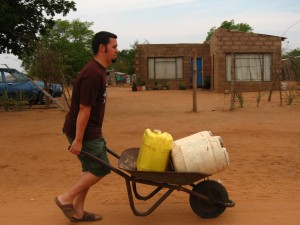
It takes two trips to fill our water containers and push them all back to our house via wheelbarrow.
According to the old racially-segregated system of Apartheid, most black South Africans were forced to live in territories known as “Homelands”, much like the original reservation system created for Native Americans. I’m told that these areas were often chosen because they were the areas that the ruling minority didn’t want – especially because of lack of rainfall and other agricultural reasons. There certainly are parts of South Africa that receive quite a lot of annual rainfall and they can grow a wide variety of crops, but that’s not our area.
Though the “Homelands” system was abolished nearly 15 years ago and black South Africans are free to move wherever they want today, many choose to remain at home near their families, in the only place they’ve known growing up: the “Homeland”.
But this year, the rain is drastically low in what’s an already dry part of the country. Some say the rain is usually supposed to start heavy around the end of August. But, the entire time we’ve been here, we’ve only seen a few light drops of rain and it usually only lasts a few minutes. Even when the rain clouds come in, they somehow miss Dumphries or just aren’t full enough to dump much water anywhere.
Of course, no one here knows why the rain is so little and so late this year. One man from a major city blamed it on Global Warming. But most people in the village have never heard of global warming and their concerns are more immediate: drinking, cooking, and growing subsistence crops.
In most normal rainfall years Dumphries is apparently overloaded with mango and avocado harvests, and each person is able to grow a significant portion of their necessary maize and vegetables. But because the rain is so late and so little this year, most people haven’t even been able to sow their regular seeds yet and they say we may get only a few mangoes, if we’re lucky. I’ve heard many related complaints about how skinny their cattle are becoming.
Most days I ask people what they think of the water situation and if rain will come anytime soon. I get a classical two-part African response: “Sure! Of course it will!” … and, “If it doesn’t come soon, we’ll all die!” followed by a chuckle and a warm smile. I suppose many South Africans are used to living on the narrow edge of needed resources, right between just enough and a woefully short supply. And yet life goes on, and that kind of light-hearted look at it all is definitely reassuring to us as the dry weeks drag on.
So, this year especially, the water source where our schools’ boreholes draw their water supply can get dreadfully low. Many children get their main meal of the day provided by the school. So the school needs quite a bit of water for their garden, for cooking all the learners’ food, and to make sure the children also have something to drink during the day. Some days when the water table is too low for the schools’ boreholes to pump enough water into their storage tanks, kids can go home hungry and thirsty.
If everyone in the village were allowed access to the schools’ short supply of water, the children certainly wouldn’t have enough. So, they have to draw a line somewhere and they decided to include us in it. Some days we feel bad for being part of the privileged few, but most days we’re just glad to have water at all.
For our own part, we use as little water as we can, to make what we have go further and to spare us more frequent trips hauling water! We have a small bowl with a small amount of water that we wash our hands in all day. We try not to bathe every day (though we often have to wash our feet), and when we do, we use a small amount of water – just enough to get our bodies wet and to wash off the soap. We try not to use many dishes to avoid water use that way and we only wash our clothes every other week and even then, only the clothes that are noticeably dirty or smelly.
Then, when we’re done with the water for each of these chores, we use it to water our small garden and some of our fruit-bearing trees. We’re also trying to get some barrels for catching rain run-off from our roof during any occasion when there’s even a few drops. Many other villagers also use this method as their principal source of water during the rainy season and it certainly saves them strenuous trips to the river. The only area we give ourselves freedom to splurge is drinking water. It’s just too often too hot to cut that short!
The good thing is, there’s good news for Dumphries on the horizon. The local municipality has been busy laying pipes to bring a water supply to the village – whereby people could access several taps throughout to have a closer, cleaner supply of water.
Some people say the municipal pipes are already finished and are complaining that the municipality simply hasn’t turned it on yet. Many hope that the water will be turned on by December this year. With South African bureaucracy the way it is, no one really knows for sure when if ever it will happen. They also say that municipal water supplies in rural areas throughout South Africa are often turned off several times a week to conserve water. But it’s certainly better than nothing and I think it must be better than what Dumphries has now. It’s a definite hope.
I’ve been planning on writing this newsletter on Dumphries’ water issues for several weeks now. And to top it all off, we had a very significant rainfall last night! It started yesterday afternoon like usual: just a few drops for a few minutes that left everyone disappointed and some very pessimistic. But by evening time, the clouds had returned and they were pouring down rain! It lasted well into the night and the sky was still overcast today, leaving the ground noticeably moist for quite some time. Everyone’s been in obvious high spirits today and some of our neighbors are beginning to hoe their yards and plant their gardens.
So, things are looking up. Maybe the municipality will finish the pipes and turn on the water supply soon. Maybe the rain was just really late, but it’ll continue strong from this point. We can only hope and pray!
(First written Oct. 18, 2008. NOTE: The municipal water supply for Dumphries wasn’t completed until March 2010, but it’s been a mostly consistent supply of good, clean water for the whole village since then.)
